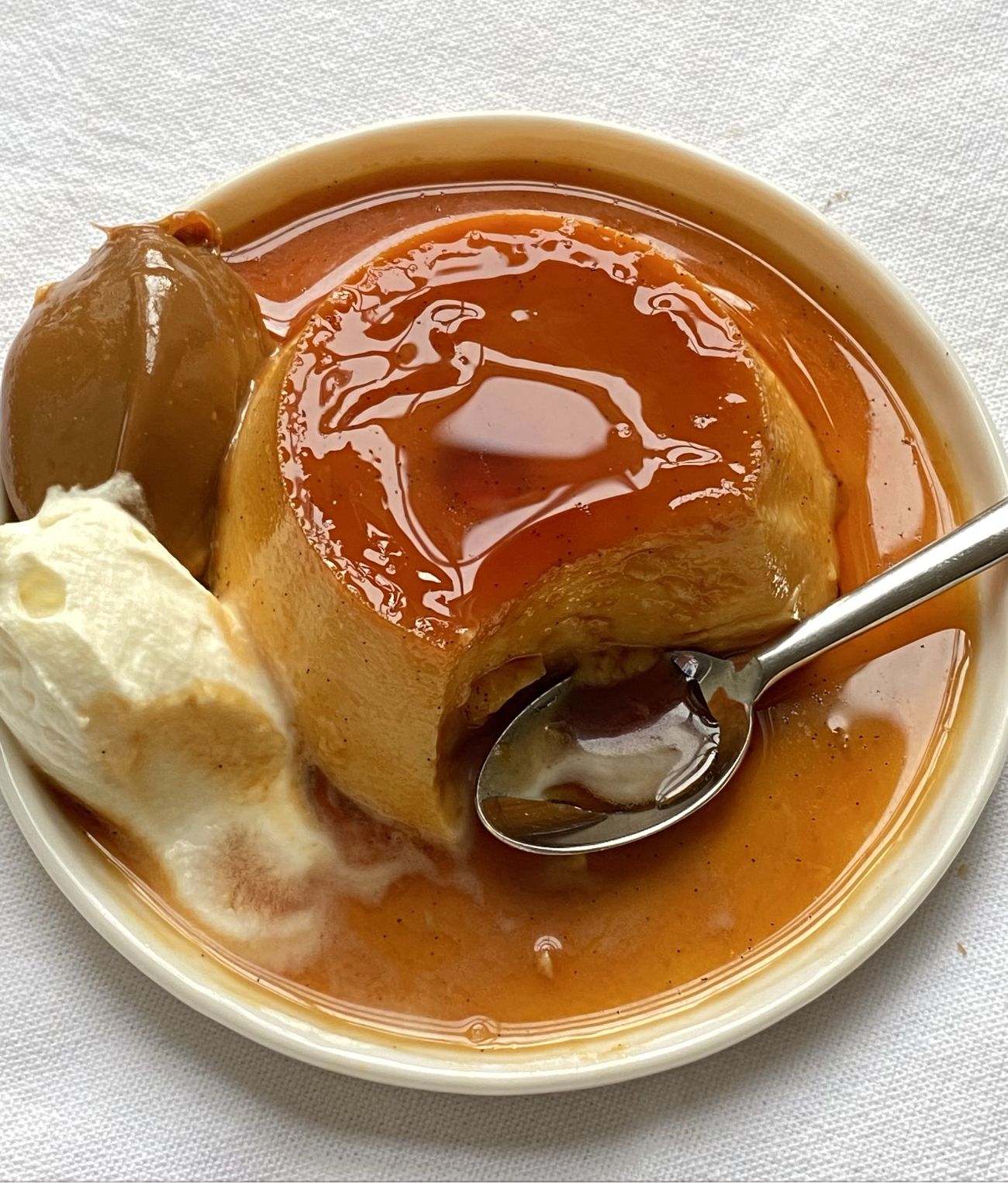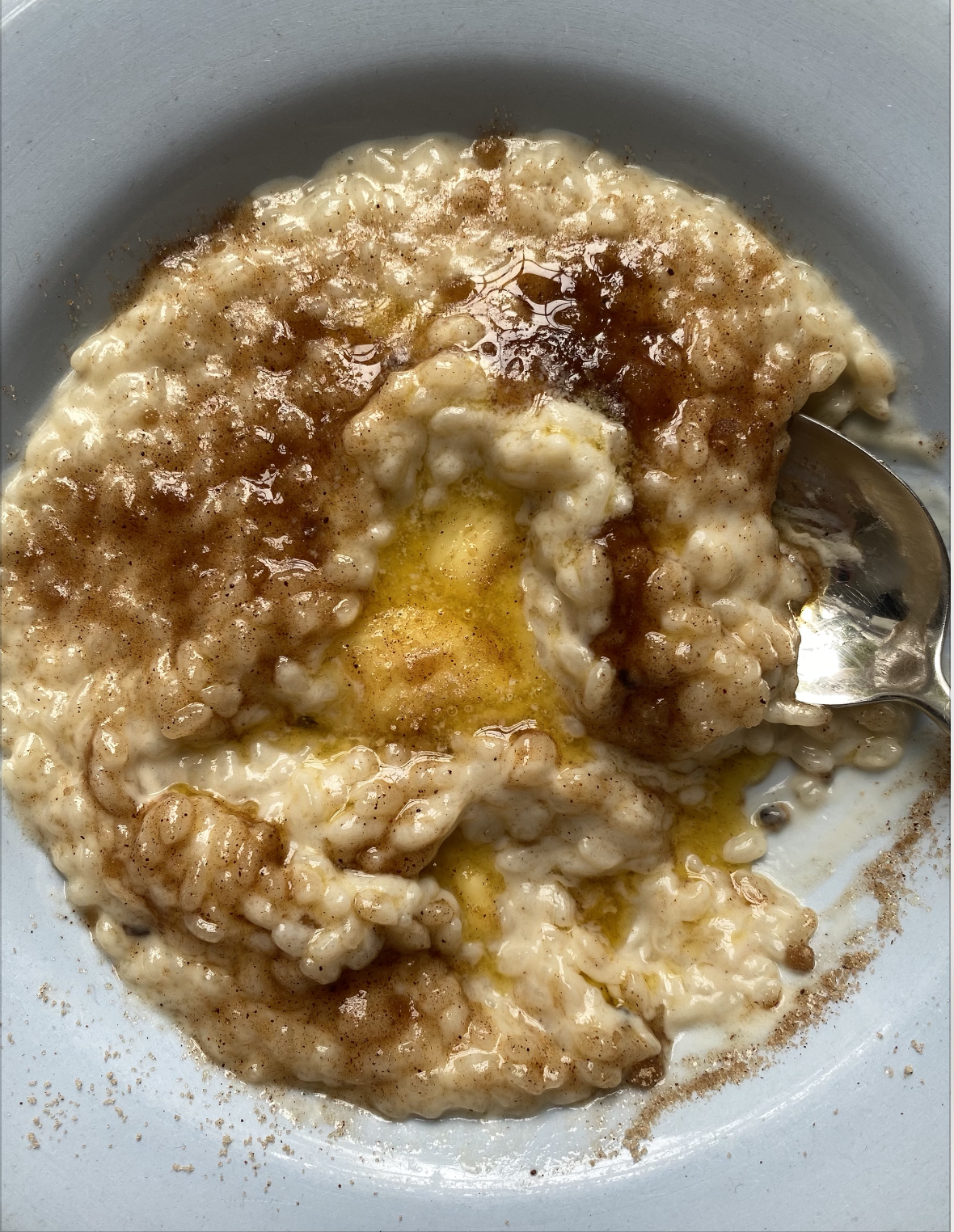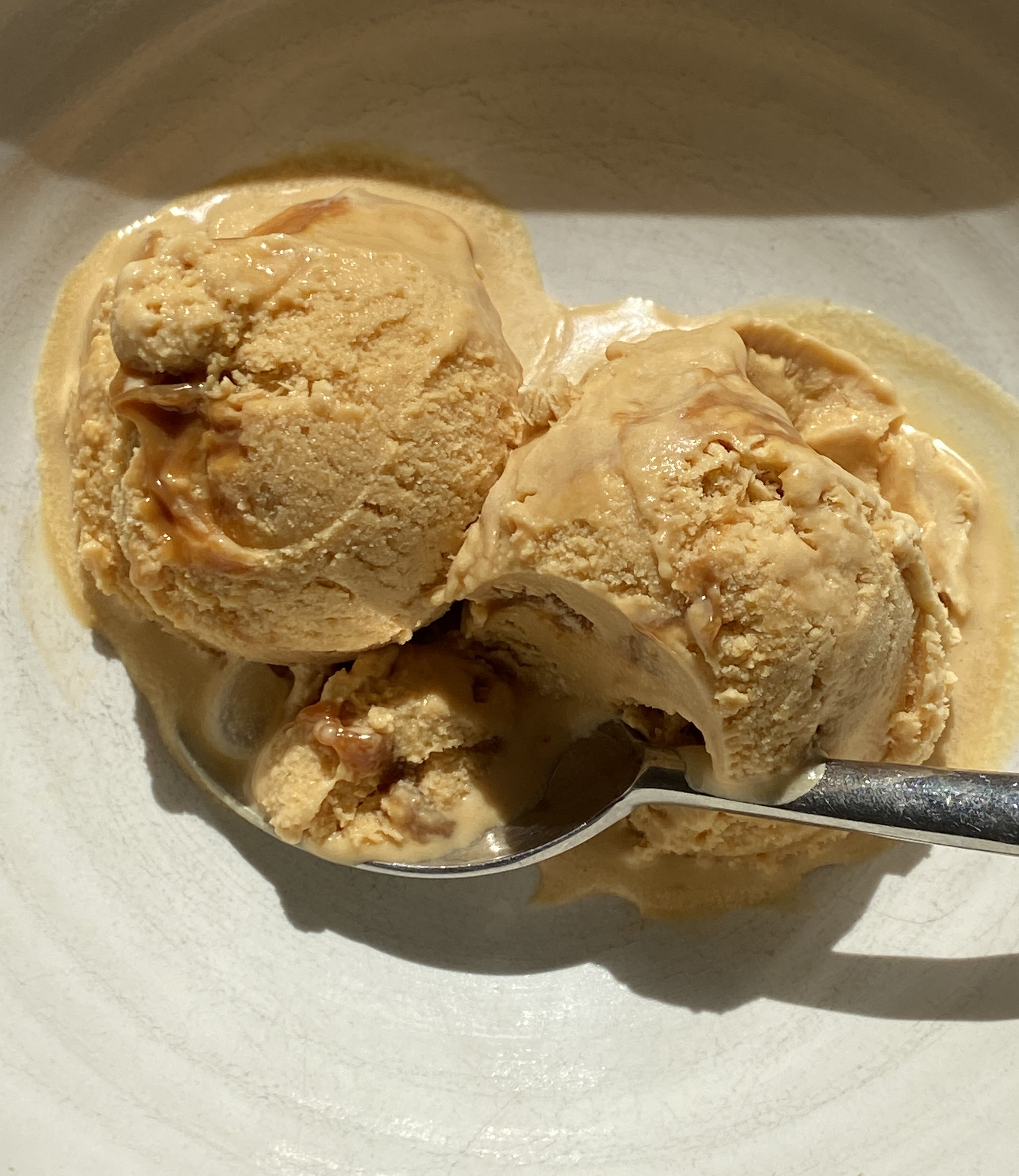Comfort Beans
Soak them on the Sunday, make and eat them plain on the Monday, turn them into a pasta e fagioli on the Tuesday and braise them on the Wednesday. Repeat the process until May.
Ingredients
500g good quality beans, soaked for 10-12 hours
1 garlic bulb, halved
2 shallots, halved
1-2 tbsp salt
100ml olive oil
2 bay leaves
Fresh thyme or rosemary
1 parmesan rind, optional
1 charred lemon, optional
Combine everything in a heavy set pot. Add enough water to submerge the beans, covering them by 4-5 cm. Bring the beans to a simmer, and cook them for 60-75 mins, until tender. Taste the broth for seasoning, it should be delish - add a little more salt if it’s not there yet. Remove the lemon, garlic,
shallot and herbs and admire them for while.
Flan for One
Chasing a childhood memory whilst simultaneously trying to make a single serve of the very best food in existence. We’re half way through January and I have both successfully avoided the outdoors and made around 8 baby flans - the two might be correlated?
Ingredients:
30g caster sugar
1 egg
40g condensed milk
40g milk
1/2 vanilla bean, scraped
Pinch of salt
Preheat the oven to 160˚C.
Sprinkle 30g of sugar to a pan in an even layer. Melt the sugar over medium low heat, without touching it. Once it has all dissolved, use a spatula to stir the sugar as it darkens in colour and until It become amber. Pour the caramel into a small flan/creme caramel tin.
Whisk the egg, sugar and condensed milk together in a bowl. To a small saucepan, add the milk, vanilla and salt and heat it over medium low heat until it nearly reaches a simmer. Whilst whisking, pour the milk into the egg mixture.
Pour the custard into the tin. Place the tin in a small baking dish, fill the baking dish with a 2-3 cm of boiling water, and cover it all with foil. Bake the flan for 35-40 mins, until set but still jiggly.
Remove the flan from the baking dish, let it come to room temperature, then place it in the fridge to set for at least 4-6 hours.
Flip it onto a plate and eat with dulce de leche.


Fig Leaf Rice Pudding + Butter
Ingredients:
Ingredients:
400ml coconut milk
300ml oat milk
3 fig leaves (skip if you can’t find them)
10-12 pods cardamom, ground
1 cinnamon stick
1 tsp vanilla extract
1/4 tsp salt
50g honey
30g butter
100g pudding rice
4 tbsp light brown sugar
Good quality butter, to serve
Add the coconut milk, oat milk, fig leaves, cardamom, cinnamon stick, vanilla and honey to a saucepan. Heat it until it reaches a simmer, then let it steep for 20-30 minutes.
Add the butter to a heavy set pot and melt it over medium heat. Heat the butter until it’s starting to brown, then add the rice and toast it for for 2-3 minutes.
Strain the milk, then add it to the rice. Simmer the rice in the milk for 18-20 minutes, until it’s tender, thick and creamy.
Serve it topped with salted butter and light brown sugar. Store any leftovers and turn them into pancakes.
Isolation Sauce
Ingredients:
Ingredients:
1 shallot, finely chopped
1 clove garlic, smashed
Olive oil, plenty
2 anchovies, optional but recommended
2-3 tbsp tomato paste
1 tin good quality chopped or plum tomatoes
Fresh basil
50g parmesan, grated
Heat olive oil in a saucepan, then add the shallots. Sauté them for 6-8 minutes, then add the smashed garlic glove and continue to cook them for 5-6 minutes.
Add the anchovies, and cook them until they break down. Add the tomato paste and cook it for 2-3 minutes, until it browns.
Add the tin of tomatoes and some salt. Simmer the sauce on medium low heat for 25-30 minutes, until thickened and jammy.
Taste for salt. Add the basil and let it wilt for 2-3 minutes.
Cook 200g of pasta and add it to the sauce along with 100ml of cooking water and half of the grated parmesan.
Serve with parmesan and a little olive oil. You can also add some burrata on top if you’re having a particularly bad day.

Seadas
Young Sardinian pecorino cooked with orange zest, lemon zest, sugar and saffron, then wrapped in dough, fried until crisp, and topped with hot honey. Woof - much more than the sum of its parts.
Young Sardinian pecorino cooked with orange zest, lemon zest, sugar and saffron, then wrapped in dough, fried until crisp, and topped with hot honey. Woof - much more than the sum of its parts.
Very few foods are as sticky, messy and mind blowing - at least to a 10 year old which was the age I first started eating them, over an initially very crisp and eventually very sticky paper tablecloth.
This recipe is inspired by the ones I ate growing up, and adapted with some tips from a Sardinian man working behind the cheese counter at Eataly - his grandmother used to add saffron and orange zest, so I added saffron and orange zest. Ps. These use butter instead of lard, which I think would be frowned upon by my cheesemonger's grandma, but you can't win them all.
Ingredients:
250g semolina flour
50g butter
100ml water
400g young Sardinian pecorino
1 lemon, zested
1 orange, zested
50g caster sugar
4-5 threads saffron
Oil, for frying
Honey
Add the semolina flour and butter to a bowl, and use your hands to combine the two together. Stir in the water and a pinch of salt, and knead the dough for a couple of minutes, until it’s soft. Let it rest in the fridge for an hour or two.
Grate the pecorino into a saucepan. Add the lemon zest, orange zest, sugar and saffron, and heat the ingredients over medium low heat, stirring until the cheese melts.
Pour the melted cheese into a baking dish and let it cool and harden in the fridge for 20-30 minutes.
Once the dough has rested, transfer it onto a lightly floured surface and roll it out until it’s roughly 1/4-1/8 cm thick.
Use a round cutter to punch out rounds of the cooled cheese, and transfer them onto half of the dough - leaving space between each one.
Fold the remaining half of the dough over the filling, as you would with ravioli. Use a larger round cutter to punch out the seadas. Use a fork or your fingers to seal the edges.
Heat around 500ml of oil in a frying pan, and heat it to around 190˚C. Fry the seadas until golden brown, 3-4 minutes.
Heat up a few tablespoons of honey and pour it over the seadas.
Dulce de Leche Ice Cream
The ice cream that momentarily takes me back to being eight years old.
It's 4 o'clock on a Wednesday, my mom picks my sister and I up from school and says we can stop at Meli Melo, a crepe cafe, on our way to swimming practice. We get a dulce de leche crepe with a scoop of dulce de leche ice cream. The crepe is warm, the dulce de leche and ice cream are melting faster than we can eat them. Our hands and faces are sticky. For just a few moments we forget we have to go swimming soon. Life is good. All through swimming we get stitches and cramps from the sugar we've just consumed. Life is still good.
To pay adequate tribute to that memory, this ice cream is heavy on the dulce de leche. It's stirred first into the base, then into the ice cream itself. While you're making it will feel like a lot, but go with it and life will in fact, be good.
Ingredients:
480g whole milk
240g double cream
450 g dulce de leche
1 tsp salt
1/2 tsp vanilla extract
Add the milk and cream to a saucepan and heat it until it reaches a simmer, then add it to a heatproof bowl. Whisk in 350g of dulce de leche until it dissolves, then stir in the vanilla and salt.
Let the ice cream mixture come to room temperature, then transfer it into the fridge and let it chill for 2-3 hours.
If you have an ice cream machine, pour the ice cream mixture in and churn it for 45-50 minutes. Dollop in the last 100g of dulce de leche and swirl it in gently.
If you don’t have an ice cream machine, pour it into a shallow dish, and freeze it for 4 hours, stirring it every 15-30 minutes. After 3 hours, dollop in the last 100g of dulce de leche and swirl it in gently.
The ice cream that momentarily takes me back to being eight years old.
It's 4 o'clock on a Wednesday, my mom picks my sister and I up from school and says we can stop at Meli Melo, a crepe cafe, on our way to swimming practice. We get a dulce de leche crepe with a scoop of dulce de leche ice cream. The crepe is warm, the dulce de leche and ice cream are melting faster than we can eat them. Our hands and faces are sticky. For just a few moments we forget we have to go swimming soon. Life is good. All through swimming we get stitches and cramps from the sugar we've just consumed. Life is still good.
To pay adequate tribute to that memory, this ice cream is heavy on the dulce de leche. It's stirred first into the base, then into the ice cream itself. While you're making it will feel like a lot, but go with it and life will in fact, be good.
Ingredients:
480g whole milk
240g double cream
450 g dulce de leche
1 tsp salt
1/2 tsp vanilla extract
Add the milk and cream to a saucepan and heat it until it reaches a simmer, then add it to a heatproof bowl. Whisk in 350g of dulce de leche until it dissolves, then stir in the vanilla and salt.
Let the ice cream mixture come to room temperature, then transfer it into the fridge and let it chill for 2-3 hours.
If you have an ice cream machine, pour the ice cream mixture in and churn it for 45-50 minutes. Dollop in the last 100g of dulce de leche and swirl it in gently.
If you don’t have an ice cream machine, pour it into a shallow dish, and freeze it for 4 hours, stirring it every 15-30 minutes. After 3 hours, dollop in the last 100g of dulce de leche and swirl it in gently.





